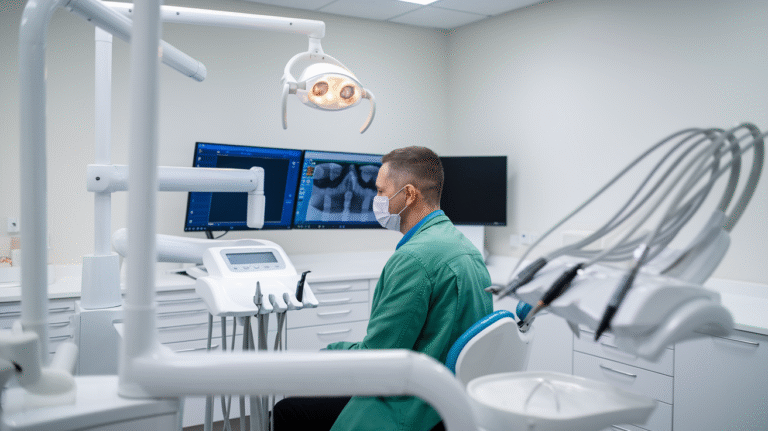Have you been thinking, “why does my tooth filling hurt after months“? You’re not alone! A filling is supposed to fix your tooth and stop pain—but if it starts hurting again after a long time, something might be wrong. You might feel a sharp sting when you chew or a dull ache that comes and goes. It’s important to understand that even if your filling felt fine at first, problems can still pop up later. Don’t worry—this blog is here to help you figure out what’s going on in simple words. We’ll walk through the reasons your tooth still hurts, what you can do to feel better, and when to call your dentist. You don’t need to guess anymore—we’ll explain everything step by step.
Many people are surprised when pain returns months after a dental filling. The truth is, even if your dentist did everything right, problems like nerve irritation, bite issues, or hidden decay can show up later. Sometimes the filling is too close to the nerve, or the filling material wears down over time, letting bacteria sneak in. Other times, your tooth might not like the filling material itself. Even habits like grinding your teeth while sleeping can slowly damage the filling and cause pain. That’s why it’s so important to pay attention to how your mouth feels and get it checked early. In this blog, you’ll learn all the real reasons behind this pain and how to make it stop—without any confusing words or scary steps.
What Does It Mean When a Tooth Filling Hurts After Months?
When your tooth filling hurts after months, it means something isn’t quite right. A filling is made to fix a hole (cavity) in your tooth and stop pain. But sometimes, even after many weeks or months, the tooth starts hurting again. This can feel like a small tingle, a sharp pain when you bite, or a dull ache that won’t go away. It could be a sign that the filling is loose, the tooth has more decay, or the nerve inside is upset. Even if it felt fine at first, fillings can have problems later. It’s not something you should ignore. Your tooth is trying to tell you something! If you feel pain, it’s a smart idea to visit your dentist. They will look at the filling and help you fix the problem before it gets worse.
Top Real Reasons Why Tooth Pain Comes Back Long After a Filling
Sometimes your tooth filling starts hurting again after many months. Why does this happen? One big reason is the filling getting old or loose. Another reason is that the filling was too close to the tooth’s nerve. If that happens, the nerve can get sore and hurt later. Also, if your bite is not even, the filling might be pushed too hard when you chew, causing pain. Some people get small cracks in their fillings from grinding teeth at night. Even bacteria can sneak under the filling and cause new decay. Sometimes your gum pulls back, and part of the tooth is exposed. All these can make your filled tooth hurt again. The pain is a warning sign, so don’t ignore it. Talk to your dentist and find out the real reason before the problem gets worse.
Is It Normal or a Problem? What Your Pain Might Be Telling You
It’s okay to feel a little sensitive after getting a filling, especially for a few days or a week. But if the tooth still hurts after many months, it’s not normal. That kind of pain usually means something’s wrong. Your tooth might be telling you it’s not happy with the filling. Maybe the filling is too high, and it’s bothering your bite. Maybe the nerve is getting damaged slowly. Or the filling wasn’t sealed well, and bacteria went inside the tooth again. The pain could also be coming from another tooth nearby, not the one you filled. So, even if you’re not sure what’s causing it, don’t guess. Pain that comes back after months needs a dentist’s help. Your dentist can take x-rays and check what’s going on inside the tooth. Getting it fixed early can save you from more pain later.
How to Know If the Filling Is Too Deep or Too Close to a Nerve
If your tooth filling is too deep, it can touch or get very close to the nerve inside your tooth. That can cause a lot of pain, even months later. Your tooth might feel sore when you bite or drink hot or cold things. You might also feel a sharp zap or deep ache that doesn’t go away. Fillings placed too deep are more likely to hurt because the nerve can get irritated or infected. Sometimes, the dentist needs to remove the filling and do a root canal to fix the problem. But not always—some deep fillings just need time or special toothpaste to help. If your pain keeps coming back or feels worse, don’t wait. Go to the dentist and tell them what you feel. They’ll check the tooth carefully and help you find the right treatment.
When Your Bite Feels “Off”: Could It Be the Filling’s Fault?
After getting a filling, your teeth should fit together just right. But if your bite feels weird—like one side is too high or your teeth don’t match up—then your filling might be too tall. This means it’s sticking out more than it should, and that can put pressure on your tooth every time you bite. That pressure can hurt and make your tooth sore. It can even lead to jaw pain or headaches. If this happens, it’s not your fault. It’s easy for a filling to be a tiny bit too high. Luckily, your dentist can fix it quickly. They just smooth it down a little, and the pain goes away. So, if your bite feels wrong after a filling, don’t wait and hope it goes away—tell your dentist. It’s an easy fix and will help your tooth feel better fast.
Can a Tooth Still Get Cavities After a Filling? Yes—Here’s How
Yes, a tooth can still get cavities even after a filling. The filling only covers the spot that had a cavity before. But if you don’t brush and floss well, new bacteria can get into other parts of the same tooth. Also, if your filling gets old, cracked, or loose, tiny food bits and germs can sneak under it. That can cause decay to start again under the filling. This new cavity might not hurt at first, but it can get worse over time and lead to pain. That’s why it’s super important to keep brushing your teeth every day and visit your dentist often. They can check if your filling is still strong and fix it if needed. Fillings help, but your tooth still needs care to stay healthy and strong for years to come.
Could It Be Allergies? Pain from Filling Materials Explained
Some people are allergic to the materials used in fillings, though it’s rare. If you have an allergy, your mouth might feel sore, itchy, or swollen near the filled tooth. The pain might not come right away—it can show up weeks or even months later. Some metal fillings (like silver or amalgam) contain things like mercury or nickel, and these can bother sensitive people. Even white fillings made of resin can cause problems for a few people. If you notice your gums are red or you feel burning near the filling, it could be an allergy. The best thing to do is see your dentist and talk about how you feel. They might do a small test or change the filling to a different kind. Once the allergy problem is solved, the pain usually goes away fast.
Grinding or Clenching at Night? Here’s Why It Makes Fillings Hurt
Grinding or clenching your teeth (called bruxism) is something many people do without even knowing it, especially while sleeping. This can put a lot of pressure on your fillings. Over time, that pressure can crack or weaken the filling, causing pain in the tooth. It might feel sore when you wake up or hurt when you chew. If the filling gets damaged, bacteria can sneak in and make it worse. Some people even get headaches or jaw pain because of all the pressure from grinding. If your dentist sees signs of wear, they might give you a night guard. It’s a soft cover you wear while sleeping to protect your teeth. Wearing this can stop the pain and keep your fillings safe. So, if your filled tooth hurts and you grind your teeth, this could be the reason.
What Happens If You Ignore the Pain? Risks of Delaying Treatment
If you feel pain after a filling and don’t do anything, the problem can get much worse. A small pain might turn into a big ache. If the nerve inside the tooth gets infected, you might need a root canal. If the tooth breaks or gets too damaged, you might even lose it. Pain is like your tooth talking to you—it’s asking for help! Ignoring the pain can also lead to more expensive treatment later. What could be fixed in one visit might take more time and money if you wait too long. The best thing is to go to your dentist early. They’ll find the problem and fix it before it becomes bigger. So don’t be scared or shy—your dentist wants to help you feel better fast!
Best Ways to Treat Tooth Pain at Home (Until You See a Dentist)
If your filled tooth hurts and you can’t see the dentist right away, don’t worry. There are easy things you can do at home to feel better. First, try using toothpaste for sensitive teeth. It helps calm the nerves. Avoid hot, cold, or sweet foods for a while. Eating soft foods is better too. You can also take a pain reliever like ibuprofen (if it’s safe for you). If you think your bite feels uneven, try not to chew on that side. Rinsing with warm salt water can help keep the area clean and reduce swelling. These are all temporary ways to help the pain go away. But remember, they don’t fix the real problem. Always make sure to call your dentist and book a visit as soon as you can. They’ll check the filling and give you the right treatment.
Conclusion
Tooth fillings are supposed to fix the pain, but if they start hurting after months, something is wrong. It could be a deep filling, a bite issue, grinding at night, or even new decay. Your mouth is trying to tell you that it needs help. Don’t ignore the signs!
Going to your dentist early is always the best choice. They can find the problem and make your tooth feel better again. Use gentle toothpaste, avoid hard foods, and protect your teeth from grinding. Keep brushing, keep smiling, and don’t wait if something feels off.
FAQs
Q: Why does my tooth filling hurt after months?
A: It might be because of nerve irritation, a cracked filling, or new decay under the filling.
Q: Is it normal to have pain months after a filling?
A: No, pain after months is not normal. You should see your dentist.
Q: Can a filling cause tooth nerve damage?
A: Yes, deep fillings near the nerve can sometimes cause irritation or damage.
Q: What helps with filling pain at home?
A: Use sensitive toothpaste, avoid hot/cold foods, and take pain relievers until you see a dentist.
Q: Can I get another cavity under a filling?
A: Yes, if the filling is loose or cracked, bacteria can get in and cause a new cavity.










